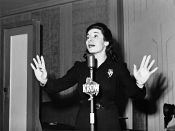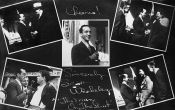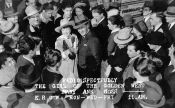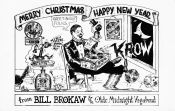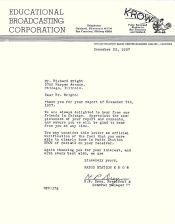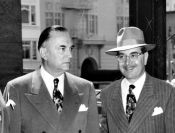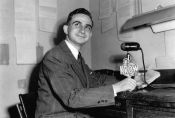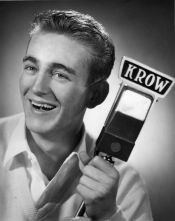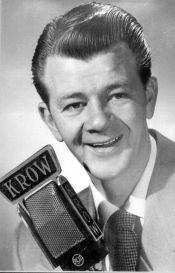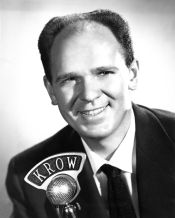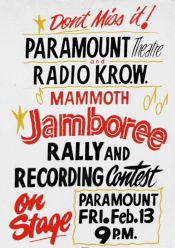|
www.theradiohistorian.org
Copyright 2021 - John F. Schneider
& Associates, LLC
[Return
to Home Page]
(Click
on photos to enlarge)
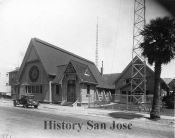
KFWM Exterior View
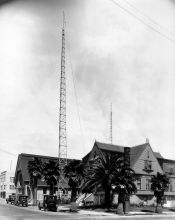
Another Exterior View, Showing the Full Antenna
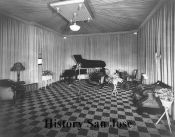
KFWM Studio
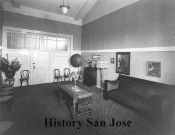
KFWM Artist's Reception Room
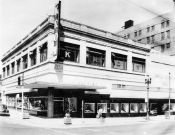
KROW Radio Center, 19th and Broadway
|
|
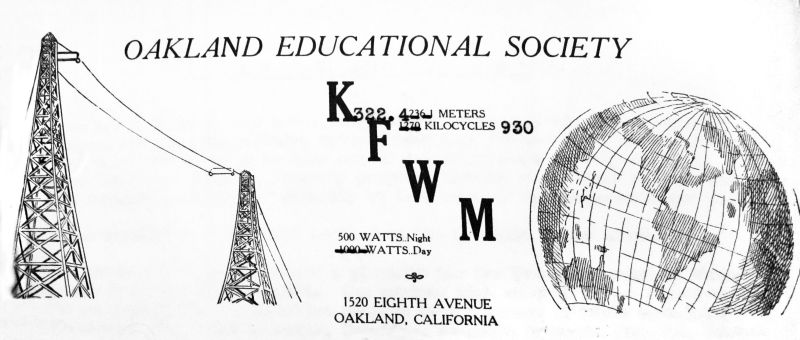
Radio station KFWM in Oakland, California, debuted in 1925,
and was known by its slogan “The Golden West Station”. It was primarily
religious in nature, owned and operated by the Oakland Educational Society, which
had a close contractual relationship with the Watch Tower Bible and Tract Society
(renamed Jehovah’s Witnesses in 1931). KFWM was authorized by the Department of
Commerce on July 8, 1925, initially approved to operate on a frequency of 224
meters/1338 kHz with a power of 500 watts. (The call letters were issued sequentially,
which was the DOC’s practice at that time – thus it was just a few letters
beyond KFWI, San Francisco, which was authorized June 29). KFWM
began broadcasting on October 15 at just 50 watts with a temporary transmitter,
until its 500-watt transmitter was placed into service the following January. The transmitter and studios were housed in a building
adjacent to the International Bible School at 1520 8th Avenue in
Oakland. (Both buildings still exist
today, and they are now home to the Bible Fellowship Missionary Baptist Church). The wire antenna was an inverted-L suspended between
two 121-foot towers. The transmitting equipment
and station facilities were built by Heintz and Kaufman, a respected San
Francisco radio engineering company. (The
transmitter was later replaced by a Western Electric 106B, and the Heintz and
Kaufman unit was placed into standby service.)
Within a few months, KFWM was required to move to 207
meters/1430 kHz and share its time with a new station, KGTT, of the Glad
Tidings Temple in San Francisco. Each
station was given 50% use of the frequency.
However, this was not to KFWM’s liking, and so in July they shifted its
frequency without authorization to 325.9 meters/920 kHz. They were taking advantage of a temporary regulatory
vacuum brought about by a court decision invalidating the Department of
Commerce’s authority to regulate the radio spectrum. (KTAB in Oakland was another so called “radio
pirate”, also shifting its frequency at that time.) The situation was resolved in 1927 when
Congress created the Federal Radio Commission, which had the legal authority to
control the radio spectrum. The new Radio Commission quickly reassigned
the frequencies of hundreds of stations, and KFWM was moved to several
different frequencies during the year. Finally in November, 1928, it was permanently
assigned to 930 kHz, which it shared with KFWI in San Francisco on a 50%/50% time
basis
The KFWM operation in the Oakland church was not without its
controversy. In 1929, residential
neighbors filed a complaint with the City of Oakland, objecting to electrical
noise and radio interference coming from the station. The city determined it had no legal jurisdiction
over the activity of radio broadcasting, and turned the complaint over to the
local federal radio inspector.
Tragedy struck at KFWM in May, 1928, when 18-year-old
William Richardson was killed while serving as a volunteer transmitter
operator. The steel nails of his hobnob
shoes accidentally came into contact with the transmitter’s high voltage generator,
electrocuting the boy. Ironically, his
death occurred while KFWM broadcast a program entitled "Does Man Go to
Heaven Immediately After Death?" The
boy’s parents filed a $50,000 lawsuit against the station. The outcome of the suit is unknown, but it’s
possible that it may have resulted in the sale of the station in January, 1930.
The KFWM license was transferred to the Educational Broadcasting
Corporation, with Henry P. Drey becoming the president, general manager and
37.9% stockholder. The remaining ownership
consisted of more than 100 individuals associated with the Watch Tower Bible
and Tract Society, with no one person’s share exceeding 10%. The transmitter and studios were moved north to
Richmond, and its power increased to
1,000 watts day, 500 watts at night. The
call letters of the station were changed to KROW shortly thereafter. While Drey was an active member of the Watch
Tower Society, the change of ownership represented a separation between the
station and the church – while KFWM had exclusively broadcast programs
originating with the Watch Tower Society, KROW was operated as an independent
station that simply carried some Watch Tower programs.
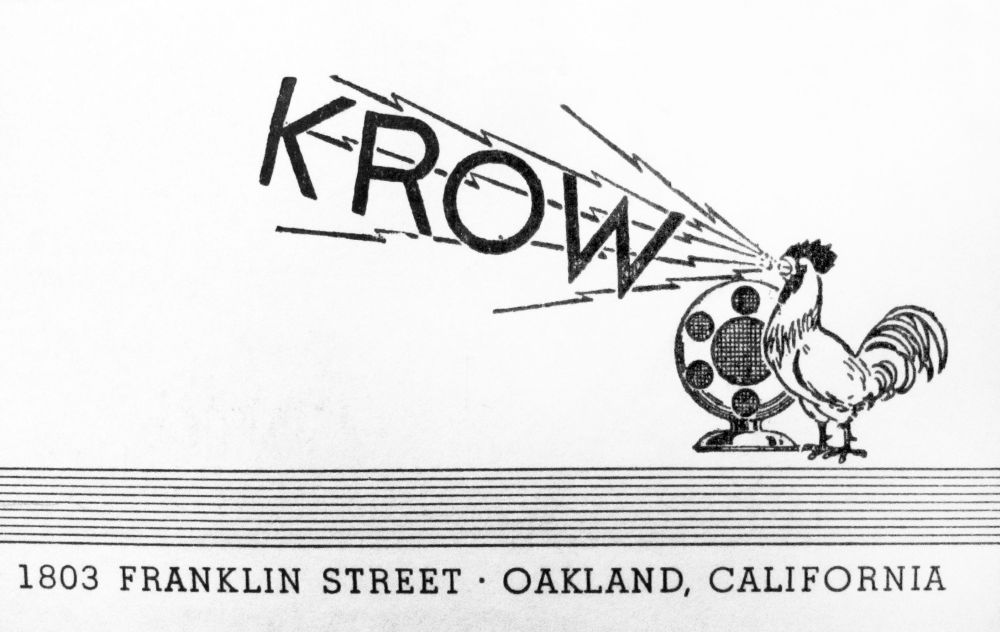
In 1933, the studios were moved to 1803 Franklin Street in
downtown Oakland and the transmitter moved back to the church. Also, in October of that year, the frequency
sharing arrangement ceased when station KFWI left the air for good, and KROW
took over the 930 kHz frequency on a full-time basis. By this time, the programming had
transitioned to a variety of popular and commercial programs, although the
Watch Tower Society’s religious programs still occupied portions of the
day.
In 1934, Scott Weakley joined KROW as its production manager,
coming west to Oakland after previous radio work in Illinois and Kansas. His midday man-on-the-street interviews were
a popular feature for many years, usually conducted on the sidewalk in front of
the station’s downtown studios. Weakley was also responsible for a great many
of the station’s special event and promotional broadcasts. He stayed with KROW until 1947 when he was
elected to the Oakland City Council, backed by local labor interests. There he suffered a difficult three years on
the council, caught up in conflicts over the issues of neighborhood urban renewal
and public housing. Ultimately, Weakley
lost a recall election in 1950 by just five votes out of 75,000 cast.
In 1936, KROW moved its studios one city block to the second
floor of the building it called “Radio Center” at the corner of Broadway and 19th
Street in downtown Oakland. The ample new
studio suite was equipped with custom studio equipment designed and built by
the broadcast division of the Remler Company in San Francisco. Construction was overseen by KROW Chief Engineer
C.E. Downey. There was a model electric
kitchen studio, used for the broadcast of housewife cooking shows. Auxiliary studios were installed in the
Bellevue Hotel in San Francisco. The
transmitter remained at its original church location.
By the mid-thirties, KROW had developed an eclectic mix of
programs. News and farm reports were
interspersed with public service programs on the subjects of health and diet. The Oakland Public Schools had a daily
program. There was an evening show
called “The Italian-American Hour”, hosted in Italian by Renato Medeot, which
ran from 1938 to 1944. Another popular
program, begun in 1932, served the ample Portuguese population of the East Bay,
and featured live music and skits hosted by an emcee. Programs in Swedish and Spanish were also
heard during the week. Watch Tower
programs were broadcast in English, Italian, Greek and Japanese. And recorded music filled the remaining
hours, principally dance and symphonic music.
In 1939, KROW was purchased for $110,000 by an investor
group led by Wesley I. Dumm, the owner of KSFO in San Francisco. Dumm was a 49% stockholder; Fred J. Hart owned 30% (he was the former
manager of KQW in San Jose, and now manager of KGMB in Honolulu); Philip Lasky,
KSFO’s general manager, owned 17.5%, and Wallace F. Elliott, 3.5%. Lasky resigned from KSFO and became the new manager
of KROW. Fred Hart reportedly sold his
interests in the station shortly afterwards.
In later years, Wesley Dumm explained that he was obligated
to honor an agreement with the Tenth Avenue Baptist Church in Oakland that he
had made when he purchased its station KTAB (later to become KSFO). The agreement stated that he would continue
to provide free air time to the church on KTAB for its “Hour of Prayer” program. However, KSFO had recently become the San
Francisco affiliate of the Columbia (CBS) Network, and CBS required control over all programs on the station. Dumm’s purchase of
KROW gave him another station on which to broadcast the church program.
In 1944, a new F.C.C. “duopoly” regulation prohibited the
ownership of more than one radio station in a community by a single entity, and
so Wesley Dumm was forced to sell his interest in KROW. It was sold again for $250,000 to KROW, Inc.,
whose principal owner was Sheldon Sackett, the owner of KOOS in Coos Bay,
Oregon and KVAN in Vancouver, Washington. Sacket held a 65% share of the station, and manager
Phil Lasky kept a 35% share and remained as manager. However, Lasky sold out in January of 1946,
went back to KSFO and soon became the manager of KPIX-TV when KSFO opened its new
TV station in 1948. Commercial Manager Wilt
Gunsendorfer was promoted to become the new manager of KROW.
KROW programs changed somewhat under Gunsendorfer. Its slogan was now “The Home Interest Station”,
with an emphasis placed on local news and community events. Station identifications included the recorded
sound of a crowing rooster. Foreign
language programs were eliminated, and more emphasis was placed on sports, with
Lloyd “Speed” Maddock announcing Pacific Coast League baseball games and hockey
games from the Winter Garden in San Francisco.
A popular mid-day news report featured John K. Chapel, hired from WOW in
Omaha in 1944. (In later years, he would
be heard on KLX, KABL and KPAT.) Scott
Weakley’s daily Man-on-the-street program followed Chapel to fill out the noon news hour. Recorded music was principally symphonic and
dance music with an evening operatic feature.
Weekends were heavy with religious programs and sports broadcasts, and
with polka and swing music on Saturday nights.
In 1945, KROW hired a young ex-Armed Forces Radio announcer
named Russ Coughlan, who soon rose to become the station’s program director. And in 1951, Alan Torbet became KROW’s general
manager. Together, they brought KROW into
the 1950’s disc jockey era, modeling it after a successful Los Angeles station.
They hit paydirt with a new KROW wake-up
show hosted by “Nick and Noodnick”. “Nick”
was Nick Nicholsen and his “Noodnick” sidekick was a young announcer named Don
Sherwood who had been let go at KCBS for not being “serious” enough. His clowning around on the air was encouraged
at KROW, with the result that the program attracted a sizeable audience. The morning team was supported with comic
bits played by the station’s ad copywriter, Phyllis Diller. The mascot of the program was a cuckoo named
Cuthbert, whose call was used as a time signal. The KROW morning show rose to number two in
the Bay Area audience surveys, right behind market leader KSFO. This attracted the latter station’s
attention, and in 1954 they hired Torbet, Sherwood and Diller away from
KROW. Torbet became KSFO’s new manager,
and Sherwood’s legendary KSFO morning show became the top-rated program in the Bay
Area until 1969. At KROW, Ray Yeager and
Bruce Sedley took over the program, becoming the new “Nick” and “Noodnick”.
Another notable KROW program host in the early 1950’s was
Rod McKuen. He had a late-night program
where he played records and read his own poetry. The result was that both he and Phyllis
Diller were hired as entertainers at San Francisco’s famous Purple Onion. McKuen subsequently rose to become a
nationally-known poet, and Diller’s stand-up comedienne act at the Purple
Onion led her to national renown in television and films. Russ Coughlan left KROW in 1957 and later
became Vice President/General Manager of KGO-TV and a respected local TV newsman. Sedley went on to host a children’s program
as “Skipper Sedley” on KRON-TV and also invented the “Zoo Key” audio narration
system used in the “Talking Storybook” machines at Lake Merritt Park.
In 1946, KROW moved from 930 to 960 kHz as part of the
nationwide shift of station frequencies occasioned by the NARBA Treaty.
Up until now, even though KROW had become a notable local
station with a well-placed downtown studio, it was continuing to broadcast from
the wire antenna at the original church location using its 1920’s Western
Electric transmitter. It was limited to
only 1,000 watts daytimes and 500 watts a night. A better transmitter system was needed to
improve the station’s coverage. Under
Wesley Dumm’s ownership, an application had been filed in 1941 to increase
power to 5 kW from a new site, but the wartime freeze on station changes put
that project on hold. Finally, in 1947,
KROW was able to lease a 20-acre island from the Port of Oakland on the north end
of the Oakland approach to the Bay
Bridge. It was dubbed “KROW Island”, and
a three-tower directional antenna system was built on the property, overseen by
Chief Engineer Downey. The move included
a power increase to 5,000 watts, giving KROW a more potent signal in the
region. At the same time, KROW filed an
application for one of the two remaining TV channels in the Bay Area – channels
9 and 11. However, there were many other
applicants and KROW was ultimately unsuccessful.
After operating the station as the sole owner since 1945,
Sheldon Sackett sold KROW to the McLendon Pacific Corporation in April of 1959 for
$800,000. The buyer was Gordon McLendon,
who operated successful Rock’n’roll stations KLIF in Dallas, KILT in Houston,
and WAKY in Louisville. McLendon’s
original plan was to duplicate his “Top 40” successes in the Bay Area, but he
quickly realized there were already four stations with similar formats. In addition to market leaders KOBY and KYA,
two more stations had just joined the pack – the Oakland Tribune’s KLX was sold
to Crowell-Collier and became KEWB, and KFRC had just converted to Top 40. The two latter stations had both abandoned “good
music” formats, and McLendon detected that this left an opening in the
market.

The radio station that had been KROW ceased to exist on May 11,
1959, after a 52-hour marathon broadcast playing the same record over and over –
“Giant Gila Monster”, which was a hat tip to a new movie of the same name being
produced by McLendon. Its radio competitors
all listened intently, expecting to soon hear the birth of a new McLendon Top
40 station. But what appeared was KABL –
the Bay Area’s newest “Good Music” station.
The format included soft instrumentals, show tunes, light classics, and an
all-classical “Symphony Hall” each evening from 8 to 10 PM. In the daytime, music was presented in 15-minute
blocks, separated by no more than three commercial announcements. Station identifications began with harp
glissandos and ended with the clanging of a cable car bell: “This is Cable,
K-A-B-L, … in the air, everywhere — over the San Francisco Bay.” The objective was to downplay the station’s
Oakland location, and this helped break the obstacle the East Bay stations had
always encountered attracting listeners and advertisers from the West side of
the Bay.
The new format was an instant success. KABL’s Hooper rating in June of 1959 was a
10.5 – a giant leap forward from KROW’s modest 2.0 the previous October. KABL had reached fourth place in the market
after just a month on the air.
KABL’s studios remained at the corner of Broadway and 19th
until August 1964, when its administrative and sales offices moved to 632
Commercial Street in San Francisco. Its
programs all originated from a small combo studio at the Bay Bridge transmitter
site. It was a lean and mean operation, but
it rode continually near the top of audience surveys for two decades.
In 1963, McLendon acquired KAFE-FM in San Francisco for
$125,000. It became KABL-FM, operating
on 98.1 MHz with 100 kW.
The radio industry began to change towards the end of the 20th
Century as the FCC gradually relaxed broadcast ownership restrictions. Individual station owners were being replaced
by large corporations building portfolios of many stations around the
country. For its part, KABL found itself
being passed from one corporate hand to another as the ever-larger station
groups swallowed each other up. In 1972, Gordon McLendon sold KABL AM/FM to
William F. Buckley Jr.’s Starr Broadcasting Group for $10.8 million. In 1978, the Starr group was acquired and
merged into Roy Disney’s Shamrock Broadcasting Company, Inc.; in 1995, Shamrock
was in turn acquired by Chancellor Media Corporation. Then in 1999, Chancellor was acquired by
Clear Channel Communications, Inc. – a behemoth investor corporation that owned
830 radio stations and 19 television channels.
(Clear Channel later changed its name to iHeart Media, Inc.)
Beginning in 1997, KABL shifted its music focus from Beautiful
Music to adult standards and big band. In
2004, the KABL call letters and format were abandoned, and the station became
KQKE “960 The Quake”, offering a progressive
talk format affiliated with the “Air America” network. In 2007 it was again re-branded as KKGN “Green
960”, featuring programs focused on environmental issues. Finally, in 2012, it became KNEW with a mix
of progressive and conservative talk hosts. (Note that the KNEW call letters had
previously been used Oakland’s 910 frequency – the old KLX and KEWB – in the
1970’s.) In 2014, Rush Limbaugh’s
conservative syndicated program moved to KNEW for a short time, and the station’s
focus shifted entirely to conservative talk programs, known as “960 The Patriot”. But this lasted only a few months, and KNEW
became a Bloomberg Network business talk affiliated station in September, 2014.
KNEW continues to be operated today by
iHeart Media, Inc.
REFERENCES:
- Broadcasting Magazine:
1/1/1932, 3/1/1932, 2/1/1936, 11/15/1938, 4/1/1939, 8/1/1939, 12/7/1942,
12/4/1944, 1/7/1946, 10/20/1947, 7/5/1948
- Radio News: Oct.
1926,
- Radio Doings, 6/7/1930, 1/25/1930
- Radio World, 8/14/1926
- Oakland Tribune, 7/10/1925, 7/21/1926, 5/23/1929, 8/30/1929,Broadcast
Weekly, 1/6/1929, 3/30/1929
- Modesto News-Herald 5/22/1928
- New York Times, "Says Rod McKuen", 4/4/1971
- Library of Congress (photos, KROW FCC historical files)
- History San Jose (photos)
- Oakland Museum (photo)
- Bruce Sedley correspondence with author 6/20/2011
- Wesley I. Dumm correspondence with author 4/2/1971
- KROW-KABL FCC History Card https://licensing.fcc.gov/cgi-bin/prod/cdbs/forms/prod/getimportletter_exh.cgi?import_letter_id=44237
- Wikipedia: https://en.wikipedia.org/wiki/KNEW_(AM)
- Bay Area Radio Museum:
https://bayarearadio.org/audio/krow-becomes-kabl
- https://localwiki.org/oakland/Oakland_Educational_Society
- http://jwdivorces.bravehost.com/rutherford2.html
- Off Camera, October 2012
https://emmysf.tv/files/2016/09/SC-Profile-Coughlan-Russ-1012.pdf
- https://localwiki.org/oakland/Bible_Fellowship_Missionary_Baptist_Church
|
